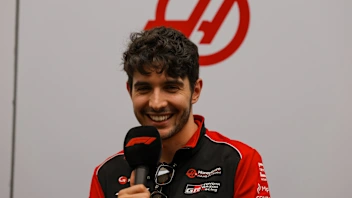FIA announces changes to 2015 calendar and rules
Formula One racing's governing body the FIA has published a number of rule changes and a revised 21-round calendar for the 2015 world championship, following a meeting of its World Motor Sport Council in Doha on Wednesday.
The expanded calendar now features a provisional slot for Korea, which hosted four Grands Prix between 2010 and 2013. The Asian country is slated to host the fifth round of next year's championship on the first weekend of May.
China meanwhile is now set to host the third round of the championship, immediately before the F1 fraternity travels to Bahrain.
Alongside the calendar changes, the FIA confirmed a number of changes to the 2015 sporting regulations. The double points regulation brought in for 2014 will be dropped, as will the proposal for standing starts after safety car periods. Meanwhile the virtual safety car system trialled in the wake of Jules Bianchi's crash in Japan will be formally introduced in 2015. The FIA also announced the findings of its ten-man accident panel surrounding Bianchi's crash.
The FIA has also tweaked engine-related penalties. A full power unit change will no longer result in an automatic penalty; instead penalties will be applied cumulatively based on the individual components of each power unit. Grid penalties will no longer roll over into subsequent races: should a driver be unable to take the full penalty, the remainder will now be applied in the form of time penalties during the relevant race.
A new ten-second penalty meanwhile has been created in addition to the existing five-second rule.
The procedure for lapped cars under safety cars has also been modified: while lapped cars will be allowed to pass the safety car and unlap themselves, the safety car will no longer have to wait until they have rejoined the back of the grid.
The criteria for the issuing of super licenses was also tweaked, with a new minimum age of 18 approved for 2016. Drivers must also have run for a minimum of two years in minor formulas.
Finally, several changes were made to the 2015 technical regulations, including a rise in minimum weight to 702kg, new limitations on wind tunnel testing, tweaks to the rules concerning suspension layouts and improved survival cell protection.
The full statement from the FIA’s World Motor Sport Council:
The 2015 FIA Formula One World Championship calendar is confirmed as follows:
15/03 Australia
29/03 Malaysia
12/04 China
19/04 Bahrain
03/05 Korea (TBC)
10/05 Spain
24/05 Monaco
07/06 Canada
21/06 Austria
05/07 Britain
19/07 Germany
26/07 Hungary
23/08 Belgium
06/09 Italy
20/09 Singapore
27/09 Japan
11/10 Russia
25/10 USA
01/11 Mexico
15/11 Brazil
29/11 Abu Dhabi
2015 F1 SPORTING REGULATIONS
The following decisions were taken:
Points
Points for both titles will no longer be doubled for the final Event of the Championship.
Standing Restarts
After consultation with the Teams who raised a number of safety concerns, Articles 42.7 and 42.8 on standing restarts have been rescinded.
Virtual Safety Car (VSC)
Following tests of the VSC system at the final Events of 2014, the introduction of the system has been approved for 2015. The VSC procedure may be initiated to neutralise a race upon the order of the clerk of the course. It will normally be used when double waved yellow flags are needed on any section of track and competitors or officials may be in danger, but the circumstances are not such as to warrant use of the safety car itself. The full text of the article is available in Annex I.
Suspending a race
When a race is suspended, the pit exit will be closed and all cars must now proceed slowly into the pit lane, not the starting grid. The first car to arrive in the pit lane should proceed directly to the pit exit staying in the fast lane, all the other cars should form up in a line behind the first car.
Team personnel or equipment on grid
If any team personnel or team equipment remain on the grid after the 15 second signal has been shown the driver of the car concerned must start the race from the pit lane. A ten second stop-and-go penalty will be imposed on any driver who fails to do this.
Power Unit Penalties
The replacement of a complete power unit will no longer result in a penalty, instead as specified in the current regulations, penalties will be applied cumulatively for individual components of the power unit.
If a grid place penalty is imposed, and the driver’s grid position is such that the full penalty cannot be applied, the remainder of the penalty will be applied in the form of a time penalty during the race (not at the next race as was previously the case) according to the following scale :
• 1 to 5 grid places untaken: A penalty under Article 16.3(a) will be applied.
• 6 to 10 grid places untaken: A penalty under Article 16.3(b) will be applied.
• 11 to 20 grid places untaken: A penalty under Article 16.3(c) will be applied.
• More than 20 grid places untaken: A penalty under Article 16.3(d) will be applied.
Time Penalties
In addition to the existing five-second penalty (Article 16.3a), a new ten-second penalty (Article 16.3b) will also be introduced, to be applied in the same manner.
Unsafe Release
If a car is deemed to have been released in an unsafe condition during a race a ten second stop-and-go penalty will be imposed on the driver concerned. An additional penalty will be imposed on any driver who, in the opinion of the stewards, continues to drive a car knowing it to have been released in an unsafe condition.
Qualifying Procedure
The qualifying procedure was clarified: for cases when 24 cars are eligible seven will be excluded after Q1 and Q2, if 22 cars are eligible six cars will be excluded after Q1 and Q2, and so on if fewer cars are eligible.
Safety Car: lapped cars
Once the last lapped car has passed the leader the safety car will return to the pits at the end of the following lap, the race director will no longer have to wait for all the lapped cars to reach the back of the pack behind the safety car.
2015 TECHNICAL REGULATIONS
- The weight of the car, without fuel, must not be less than 702kg at all times during the Event (up from 701kg).
- Changes have been made to the rules governing Wind Tunnel Testing and with regard to the aerodynamic reporting periods for 2015 and 2016.
- Any suspension system fitted to the front wheels must be so arranged that its response results only from changes in load applied to the front wheels.
- Any suspension system fitted to the rear wheels must be so arranged that its response results only from changes in load applied to the rear wheels.
- The Zylon anti-intrusion panels on both sides of the survival cell have been extended upwards to the rim of the cockpit and alongside the pilot’s head.
NEXT MEETING OF THE STRATEGY GROUP
The FIA President confirmed that the next meeting of the Strategy Group would take place on 18 December, and would focus reducing costs, improving the show, making cars quicker and more difficult to drive, and reviewing the technical and sporting regulations, with the aim of simplifying the rules where possible.
ACCIDENT PANEL
A review of all the evidence and other information about the events leading up to Jules Bianchi’s accident at the Japanese Grand Prix 5 October 2014, Suzuka, has been carried out by the 10-man Accident Panel, appointed by the FIA and chaired by Safety Commission President Peter Wright. The Panel has issued a 396-page report on their findings with recommendations for improvements, many relevant to all of motor sport. This has been presented to the FIA World Motor Sport Council, which accepted the findings and gave a mandate to implement the full recommendations and conclusions of the report. The summary issued by the panel can be found on fia.com.
CRITERIA FOR THE ISSUING OF SUPER LICENCES
A proposal on the conditions of attribution of the Super Licence was approved for 2016, on the basis of the following criteria:
1 - Safety criteria
The following changes have been made compared to the current regulations:
- There is a valid driving licence requirement.
- There is a minimum age requirement (18yo).
- There is a verification of knowledge of the F1 Sporting Regulations/ISC rules.
2 - Experience criteria
With the following changes compared to the current regulations:
- There is the 300km in F1 TCC or TPC_ as a minimum requirement.
- There is a 2 years minimum running in minor Formulas.
3 - Performance criteria
With the following changes compared to the current regulations:
- There is a point system requirement, based on the driver results in previous Formulas.
Next Up
Related Articles
 Piastri 'will be a world champion' in future – Norris
Piastri 'will be a world champion' in future – Norris JacquesHow did the rookies do in their first F1 season?
JacquesHow did the rookies do in their first F1 season?.webp) VOTE: Choose your favourite race of the 2025 season
VOTE: Choose your favourite race of the 2025 season Power RankingsWho did our judges rank as the best F1 driver of 2025?
Power RankingsWho did our judges rank as the best F1 driver of 2025? ‘I have achieved my dream, that little boy's dream’ – Norris
‘I have achieved my dream, that little boy's dream’ – Norris Getting to know the real Esteban Ocon
Getting to know the real Esteban Ocon